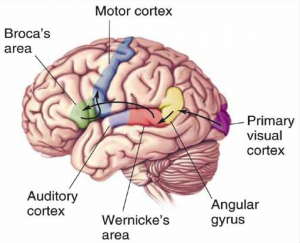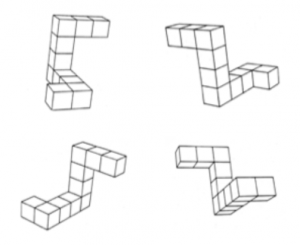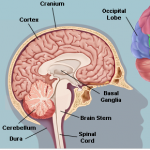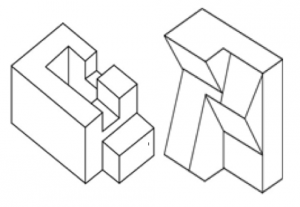“Imagine you’re reading a story, and each word takes your whole soul to pull off the page.”
According to Ken Pugh, President of Haskins Laboratories, this is how it feels to read written words for people with reading disabilities. Having a reading disability can make simple daily procedures tedious, and can especially be a hindrance to children’s learning, which relies heavily on reading. Although the burdensome aspect of dyslexia has long been in the spotlight, Pugh recently showed that dyslexic children may, in fact, have an advantage in certain kinds of visuospatial processing.

Image courtesy of The International Dyslexia Association.
The human brain is not wired to read
People seem to be wired to acquire language. As babies, humans don’t need to be specifically taught to speak. They start babbling after merely hearing their parents’ speech. This is because humans are born with two areas in their brain’s left hemisphere called Broca’s and Wernicke’s areas, which play critical roles in speech production and language comprehension. Although we start speaking instinctively, the human brain is not wired to read. Reading is a manmade cognitive invention created to record language in a visual form. It is only through repeated practice that the brain develops neural circuitry that connects the visual perception of letters to the sounds and meanings of words. A small difference in the brain can make it extremely difficult for the brain to exhibit the plasticity necessary to form the neural circuitry for reading. Considering the manmade nature of reading, it is not surprising that there are more individuals who have trouble reading than comprehending spoken word. According to the International Dyslexia Association (IDA), disabilities in reading may affect up to 20 percent of the population.

Image courtesy of Dr. Ken Pugh, Haskins Laboratories.
Two main differences found in dyslexic brains
As Pugh says with pride, Haskins Laboratories has long been considered “a national treasure for research on how human beings read” by the National Institute of Health. As a private, non-profit research institute that is affiliated with Yale, Haskins Laboratories has been conducting studies about speech and reading and associated disabilities since 1935. This July, Pugh published a study that investigated the difference in brain activity between dyslexic and typically developing children when doing tasks that require visuospatial processing. Pugh’s team assigned various tasks to participants with varying reading abilities. The participants’ speed and accuracy in response were recorded in normal settings and in fMRI scanners.

Image courtesy of Peters, M. & Battista, C. (2007). Applications of mental rotation figures of the Shepard and Metzler type and description of a mental rotation stimulus library. Brain and Cognition, 66, 260–264.
The researchers made two key findings that contribute to the field of reading disability research. First, they refuted the notion that dyslexia is caused by fundamental dysfunction of key neurobiological systems involved in learning. They did this by analyzing the activity of the basal ganglia, a brain structure that plays a fundamental role in skill learning, in both dyslexic and typically developing individuals. The basal ganglia is activated more when an individual is doing something that requires greater cognitive effort. Interestingly, this study showed that the basal ganglia in children without reading disabilities is more activated when processing figures than print. In contrast, the basal ganglia in dyslexic individuals is more activated when reading print than when processing figures. This finding shows that the basal ganglia processes figures relatively easily in dyslexic individuals. This kind of activity would not be expected if the system were generally damaged. In correlation with this finding, it was shown that dyslexic individuals take less time to accurately complete the tasks that require visuospatial processing of complex figures than children who can read well. In this domain, dyslexic individuals have a slight advantage.
The study’s other main finding is perhaps even more significant. When observing the brains of children who can read, the researchers found that the left hemisphere was activated when processing language, while the right hemisphere was activated more when processing visuospatial stimuli. Meanwhile, dyslexic brains, which lack the specialization for language processing in their left hemispheres, have less hemispherically differentiated activity. Unlike the reading brain, both hemispheres were activated when processing visuospatial information. This supports the crowding hypothesis or the hemispheric tradeoff hypothesis, which dictates that specialization of brain areas for certain tasks can leave less room in the brain to process other tasks. Specialization of brain areas may indeed come with a cost.

The motivation for a different angle of research
The focus of this study is different from those of previously conducted studies. Most traditional studies have focused on the disadvantages of dyslexia. For example, Haskins Laboratories conducted studies that showed that the degree to which print and speech activate the same neural tissue determines reading ability. Their finding was that in skilled readers, the Broca’s and Wernicke’s areas are activated both when listening to words and when reading them. In dyslexic individuals, however, such areas are activated only by speech, while print activates different areas of the brain.
Although such findings are useful in developing treatments for dyslexia, Pugh also sees the importance of studying the advantages dyslexic individuals may have. He points out that many individuals with reading disabilities pursue careers in art, architecture, and engineering, which allow them to make use of their heightened visuospatial abilities. Despite this anecdotal evidence, only a handful of researchers had conducted studies that investigated the advantages dyslexics may have.
“Deep down,” says Pugh, “what motivated me, having worked with children with dyslexia for so long, and having seen how damaged they can be from a world that keeps telling them that they are not good at things, was the possibility that we could identify strengths. Perhaps by leveraging these strengths we can help these terrific kids to more fully bring out their talents and self-esteem.”
More questions
However, this study leaves us asking more questions. People with reading disabilities have a slight advantage in processing certain kinds of visuospatial stimuli—but is this advantage a cause or a consequence of reading disabilities? Do individuals born with enhanced visuospatial capabilities later develop reading disabilities? Or do dyslexic individuals read less, and therefore develop higher non-language visuospatial abilities? Pugh is now trying to address this question. His research team will work with children under four years old with high risk for dyslexia to investigate whether they have a visuospatial processing advantage compared to their typically developing peers before they learn to read. They will then track these children and observe how many of them later show symptoms of dyslexia. The results of this new study could take dyslexia research a step closer to finding the cause of reading disabilities.

Image courtesy of Schacter, D.L.,Cooper, L.A.,Delaney, S.M., 1990. Implicit memory for unfamiliar objects depends on access to structural descriptions. J. Exp. Psychol. Gen. 119 (1), 5–24. https://dx.doi.org/10.1037/0096-3445.119.1.5
Pugh’s study could bolster discouraged dyslexic students by showing them the advantages that their reading disabilities could give them. But it is important to remember that the slight visuospatial processing advantage that dyslexic individuals have does not outweigh the inconvenience of being unable to take in written information at a normal pace. Pugh emphasizes that the first and most important step for children with reading disabilities is for their parents to seek evidence-based treatment for their children. He worries that these new findings could be misinterpreted. For instance, he says the idea that helping dyslexic children read better might cause them to lose their other advantages is “not sensible, because everything we know about the brain suggests that we can be an expert at lots of things.” Given appropriate attention to language and reading at an early age, children with dyslexia can be treated in most cases, due to the high plasticity of the human brain.
If, in the future, Pugh shows that children have such advantages even before learning how to read, further research can be done to identify genes that could give rise to such differences in the brain. As Pugh’s dedication suggests, this study impacts not only the field of reading disability research, but also the real lives of dyslexic children. Incorporating knowledge of the cognitive trade-off dyslexic children have into education could introduce motivation and positivity into what has been a bleak attitude toward a widespread disability.

Image courtesy of Dr. Ken Pugh.
Extra Reading:
- Pugh, Kenneth, Stephen Frost, Douglas Rothman, Fumiko Hoeft, Stephanie Del Tufo, Graeme Mason, Peter Molfese, W. Einar Mencl, Elena Grigorenko, Nicole Landi, Jonathan Preston, Leslie Jacobsen, Mark Seidenberg, and Robert Fulbright. 2014. “Glutamate and Choline Levels Predict Individual Differences in Reading Ability in Emergent Readers.” The Journal of Neuroscience 34 (11): 4082-4089.
- Diehl, Joshua, Stephen Frost, Gordon Sherman, W. Einar Mencl, Anish Kurian, Peter Molfese, Nicole Landi, Jonathan Preston, Anja Soldan, Robert Fulbright, Jay Rueckl, Mark Seidenberg, Fumiko Hoeft, and Kenneth Pugh. 2014. “Neural Correlates of Language and Non-language Visuospatial Processing in Adolescents with Reading Disability.” Elsevier 101: 653-666.
- Winner, Ellen, Catya Von Karolyi, Daphna Malinsky, Lisa French, Colleen Seliger, Erin Ross, and Christina Weber. 2001. “Dyslexia and Visual-Spatial Talents: Compensation vs Deficit Model.” Elsevier 76 (2): 81-110.
About the Author: Yuki Hayashi is a sophomore in Ezra Stiles College majoring in the neuroscience track in Psychology. She plans to work in the Human Neuroscience Lab and pursue her interest in the mechanisms of brain-based disabilities.
Acknowledgements: The author would like to thank Dr. Ken Pugh of Haskins Laboratories for elaborating so enthusiastically on his studies on dyslexia.
